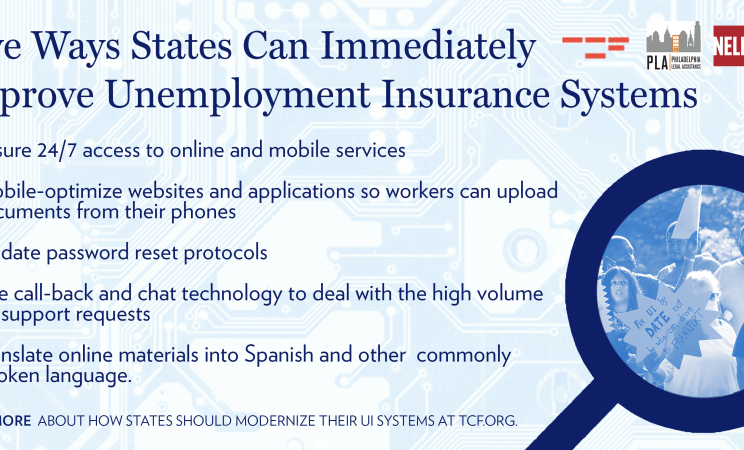Centering Workers—How to Modernize Unemployment Insurance Technology

Executive Summary
This report, jointly authored by The Century Foundation, the National Employment Law Project, and Philadelphia Legal Assistance, presents the findings of an intensive study of state efforts to modernize their unemployment insurance (UI) benefit systems. This is the first report to detail how UI modernization has altered the customer experience. It offers lessons drawn from state modernization efforts and recommends user-friendly design and implementation methods to help states succeed in future projects.
While the need for better systems was apparent even before the COVID-19 pandemic struck, that crisis has illuminated the challenges with the existing UI infrastructure. This report includes specific recommendations that can inform the federal and state response to the unprecedented volume of unemployment claims during the pandemic, as well as ideas for longer-term reforms.
What Is Benefits Modernization?
Benefits modernization is the process of moving the administration of unemployment benefits from legacy mainframe systems to a modern application technology that supports web-based services. Many of these mainframe systems were programmed with COBOL, a long-outdated computer language. A few states began to upgrade their systems in the early 2000s, with the pace picking up after targeted federal funds were made available to support modernization in 2009.
Unfortunately, many of the initial modernization projects encountered significant problems. Some were abandoned altogether, while others were poorly implemented. Too often, workers paid the price through inaccessible systems, delayed payments, and even false fraud accusations. The COVID-19 pandemic, which led to an unprecedented spike in unemployment claims, has further exposed weaknesses in these systems.
To date, fewer than half of states have modernized their unemployment benefits systems. Several have plans to modernize or are already in the midst of modernizing. The guidance in this report is meant for them, as well as for modernized states that are looking to improve their systems.
Research Methods
The findings and recommendations in this report are grounded in interviews with officials from more than a dozen states and in-depth case studies of modernization in Maine, Minnesota, and Washington, conducted from October 2018 to January 2020. The case studies involved many hours of in-person discussions with agency leadership and staff, focus groups with unemployed workers, and interviews with legal services organizations, union officials, and other stakeholders.
The report provides lessons for states no matter which pathway to modernization they choose. In fact, the three states featured in the case studies took notably different approaches. Minnesota was one of the first to modernize in 2007, and while it used a private vendor, the code remains the property of the state agency. Washington contracted directly for a proprietary commercial off-the-shelf (COTS) system which rolled out in 2017. Maine also modernized in 2017, but as part of a consortium, meaning that it shares system and maintenance expenses with two other states (Mississippi and Rhode Island).
To complement the interviews and case studies, this report presents new data analysis, suggesting that while timeliness in processing claims and paying benefits improved in many states after they modernized, denial rates went up for workers seeking benefits and the quality of decisions declined.
The report also examines the growing use of artificial intelligence and predictive analytics in unemployment insurance. It concludes that, while some of these tools can improve operations and potentially help workers better understand program requirements, major concerns about fairness, accuracy, and due process remain.
Recommendations
The single strongest recommendation in this report is for states to place their customers at the center of a modernization project, from start to finish. The biggest mistake states made was failing to involve their customers—workers and employers—at critical junctures in the modernization process. This led to systems touted as convenient and accessible, but which claimants often found challenging and unintuitive. Customer-centered design and user experience (UX) testing are widely accepted best practices in the private sector, and should be a core part of any UI modernization effort.
At the planning stage:
- setting a realistic timetable and to avoid rushing implementation;
- embedding talented agency staff in a modernization effort and getting their buy-in every step of the way;
- asking customers what they need;
- being willing to revamp the agency’s business processes along with the technology; and
- identifying key conditions up front in an RFP (for agencies using outside vendors).
At the design stage:
- getting user feedback from a broad range of stakeholders;
- allowing plenty of “sandbox” time for agency staff; and
- building in a set of key features that will help customers and reduce the burden on agency staff.
At the implementation stage:
- not going live in the November–March period, when seasonal claims rise;
- considering rolling out pieces of a new system in stages;
- training and supporting staff on an ongoing basis;
- staffing up call centers and deploying additional staff to career centers;
- having a robust community engagement plan;
- expecting bugs and having a process in place to fix them; and
- providing for ongoing feedback from customers and front-line staff.
The pandemic has revealed how critically important unemployment insurance is to workers, their families, and the broader economy. By following the steps outlined in this report, states can build stronger unemployment systems that deliver the services and benefits their customers need.
What States Can Do Right Now
The release of this report coincides with the emergence of one of the greatest challenges the unemployment insurance system has ever faced: the COVID-19 pandemic. More than 10 percent of the workforce filed initial claims for unemployment in a three-week period in March and April, and job losses continued to rise thereafter.
State systems have been overwhelmed by the basic task of accepting claims, and workers are frustrated. Luckily, there are immediate steps states can take to improve access, even within outdated systems. Some states are already moving to implement these reforms, and others should follow their lead as quickly as possible.
Michigan is a good example of a state that has turned around a poorly engineered system into one that is serving workers well during the pandemic. While the original system had been modernized, the new system was designed with a faulty algorithm that inaccurately flagged workers for fraud and cut off benefits at every decision point. A new governor appointed a claimant representative to head the agency, and less than a year later, the system faced the massive challenge posed by the COVID-19 outbreak. The new leadership identified places in the system that placed an unnecessary hold on benefits and turned off those chokepoints. As a result, the agency became the second-fastest in new benefit processing among the ten states with the largest numbers of claims,1 and one of the first states to stand up the new Pandemic Unemployment Assistance benefit and the Pandemic Unemployment Compensation benefit authorized by the CARES Act.
Our recommendations for what states can do now come from our study of best practices at the state level. While states are unlikely to be able to fully replace their UI systems in the midst of this crisis, they can and must improve their technology. Here are six key areas for immediate improvement.
First, unemployed workers need 24/7 access to online and mobile services. We live in a country where you can shop online at any hour of the day. Filing for unemployment shouldn’t be restricted to nine to five on weekdays.
Second, unemployment websites and applications must be mobile-optimized. More people have mobile phones than desktop or laptop computers, and public access to computers has vanished in an era of social distancing. Low-wage workers and workers of color are particularly likely to rely on their phones for Internet access. While more than 80 percent of white adults report owning a desktop or laptop, fewer than 60 percent of Black and Latinx adults do. States must also allow workers and employers to email documents or upload them from their phones.
Third, states should update their password reset protocols. In some states, workers must be mailed a new password; in others, staff cannot process claims because they are busy answering phone calls about password resets. Technology exists for states to implement secure password reset protocols that do not require action by the agency, which saves time for everyone.
Fourth, states can use call-back and chat technology to deal with the unprecedented volume. These short-term fixes could become part of a permanent solution. “Call back” systems return a worker’s phone call instead of making them wait on hold. Chat-bots, live chats, and thought bubbles can define terms and answer simple questions for workers filing online.
Fifth, states should adopt a triage business model. Many of the questions coming into the call centers relate to passwords or claim status. Using a triage model, states can quickly train staff to handle this part of the volume, and leave more challenging questions to more experienced staff.
Finally, civil rights laws require that states translate their websites and applications into Spanish and other commonly spoken languages. Right now, an unemployed worker with limited English skills may have no choice but to file an application over the phone with an interpreter. With so many seeking help, workers may never get through on the phone or can get stuck on hold for hours. Translating online materials would not only ensure equal access, but also be more efficient.
Even if these measures take a number of weeks or months to implement, the investment would be well worth it. The employment crisis triggered by the pandemic has highlighted gaping holes in accessing unemployment, but it has also created an opportunity. We can build twenty-first-century systems nimble enough to handle disasters and designed to meet the needs of customers who are depending on access to unemployment insurance in this traumatic time.
